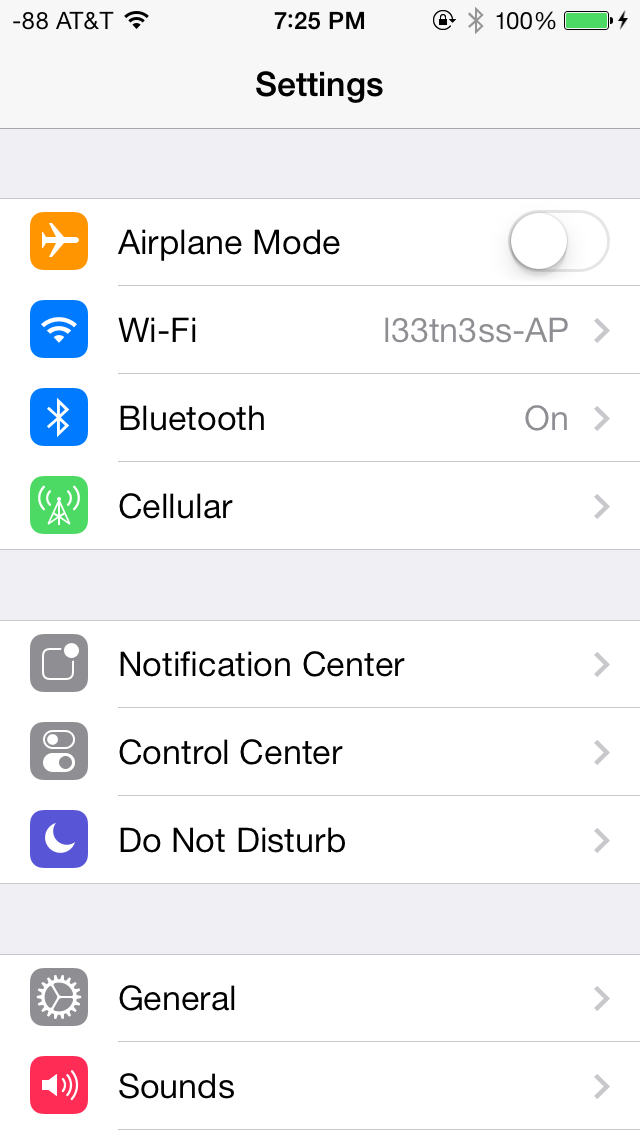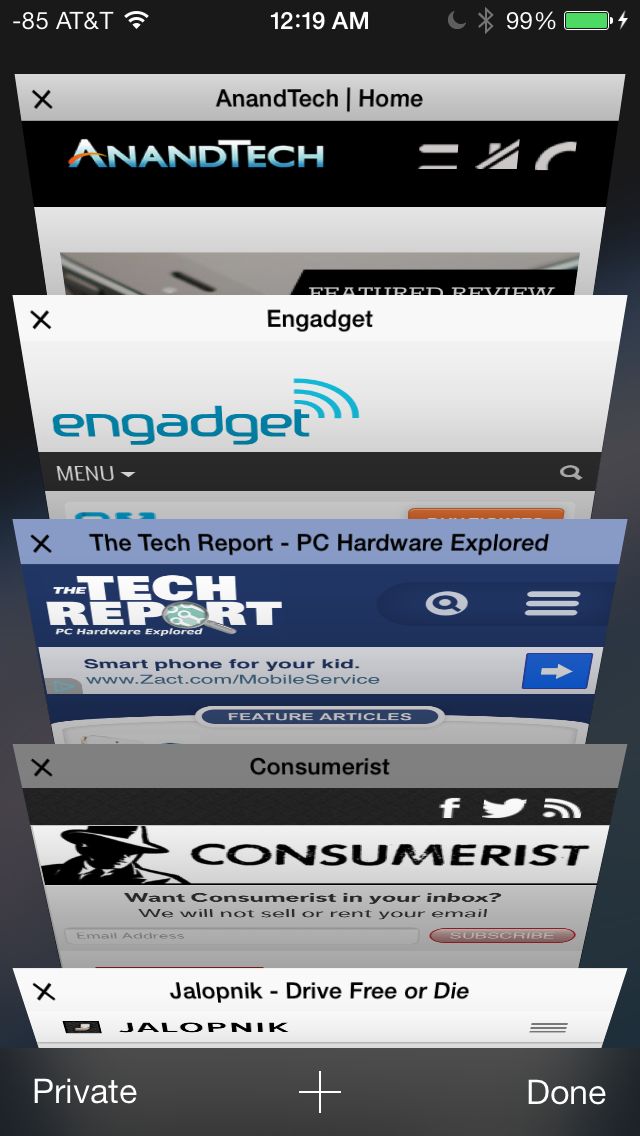The iOS 7 Review
by Brian Klug & Saumitra Bhagwat on September 19, 2013 1:25 AM ESTSettings
The changes in Settings.app are primarily visual at a high level. The application icon is perhaps the most curious change, since it looks like a sprocket for a bicycle or the gears inside a watch now, but I digress. This new UI pretty much just has visual style that matches the rest of iOS 7, and doesn’t really fundamentally change organizational structure very much. Settings are still grouped together in a couple of logical little bunches, with a bunch of third party application-specific settings options at the very bottom.
There’s obviously the addition of control center inside settings, and do not disturb comes outside of notifications. There are also the appropriate toggles for the today view under notification center. Under general and accessibility there are new options for the dynamic font size functionality, and a new toggle for disabling noise cancelation which proved somewhat controversial on the iPhone 5 (this setting also carries over to the 5s but not the 5c which I suspect lacks earpiece noise cancelation).

Safari
iOS 7 brings mobile safari version 7, which gets a huge set of functional changes and improvements to the JavaScript engine. Safari has been around for a while without many big changes to the interface, so this is big one.

There’s now a unibar at the top of the page for both URLs and search terms, this is a long overdue and welcome change that makes a ton of sense. Safari also now preloads the first result in the list while you’re typing, which has the side effect of making loading feel much faster regardless of what device you’re coming from.
The unibar also looks through bookmarks that are either synced through iCloud or exist on the iDevice and exposes those as options. It’s a bit confusing though since there are both the bookmarks under that appropriate menu, and bookmarks from the bookmarks bar that appear when you tap on the unibar on an empty tab before you start typing. I didn’t realize I even had some of those bookmarks still around until iOS 7 swung around and exposed them.
The new mobile safari gets the same transparent overlays and sense of depth that the rest of the OS conveys, the pages render below most of the UI and there’s a bit of hinting from elements that peek through. A big change is that the bottom menu now also slides away as you scroll down a page, expanding the viewport accordingly. The top bar gets smaller but retains the domain of the page being visited. Tweaks like these do help the iPhone feel bigger than it used to feel.
In addition you can now have more than 8 pages open at the same time, and safari seems a lot better at keeping tabs around and not reloading their contents every time you switch between them. The tab switching interface is also a lot better, with a card-like metaphor that allows for tabs to be quickly closed by just swiping them off the left of the display. The only slightly unnerving issue here is that the tabs aren’t antialiased during the animation and for a slight moment or two after it stops, then suddenly the edges no longer have jaggies. It’s a disconcerting subtle thing I can’t stop seeing every time I change tabs in the new mobile safari.
If the signal dots are my least favorite part of iOS, then the changes made in mobile safari and the addition of control center are my favorite.
Benchmarks
Apple usually makes improvements to its JavaScript engine (Nitro) whenever it can, and the iOS 7 mobile safari release is no exception. There’s a 15 percent difference in sunspider and browsermark, and a larger one closer to 50 percent in kraken and google octane, webxprt sees a 30 percent jump. This is comparing two iPhone 5 models running iOS 6.1.4 and the iOS 7.0 GM. HTML5 score increases as well with the addition of a few new features, and WebKit moves from 536.26 to 537.51.1.
| iOS 6.1.4 | iOS 7 GM | |
| Sunspider 1.0 (ms) | 836.6 | 721.1 |
| Browsermark 2.0 (score) | 2587 | 2998 |
| Kraken 1.1 (ms) | 20388.0 | 14050.6 |
| Google Octane (score) | 1706 | 2856 |
| WebXprt (score) | 176 | 231 |
| HTML5test.com (score) | 386+9 | 399+9 |













144 Comments
View All Comments
prophet001 - Friday, September 20, 2013 - link
I got that part. What I was referring to was how he mentioned that there had previously been a lack of change between OS versions. With iOS 7 though, Brian asserts, there are radical changes. Immediately following his claim is a picture of two identical screens. One screen iOS 7 and one screen iOS 6. This undermines his claim that "almost every part of the OS gets some kind of change."solipsism - Thursday, September 19, 2013 - link
My biggest complain with the new UI is that with Maps giving you directions the "slide to unlock" button is so faint that I too often can't figure out why the Maps app isn't responding as I think it should. (See last image on first page of review)solipsism - Thursday, September 19, 2013 - link
Additionally…2) I might be in the minority here but I'm not a fan of the way Safari shows multiple pages. it's *neat* looking but like Windows Vista's Aero Flip 3D effect it's not very useful if you need to quickly distinguish between multiple similar pages at once. I'd much rather it be like the new Fast App Switcher in iOS 7.
3) It's great that iOS finally has a Control Center and it's great that it's accessible from the Lock Screen, but it should not allow one to enable Airplane Mode (or disable any wireless communication) without having to use a PIN/Touch ID for verification. Sure, you can turn off Control Center from being accessible from the Lock Screen but that's all or nothing.
4) Very, very minor but I am not a fan of most of the new icons. That said, I ultimately don't care about how a fraking icon looks so all things considered the pros far outweigh the cons.
Impulses - Thursday, September 19, 2013 - link
Wait what? You can pick up a locked iPhone and switch it into airplane mode without ever needing the PIN? How would they miss that?? Seems like such an obvioususability/security flaw... Wouldn't that make it ridiculously easy to steal phones and not worry about tracking/find phone features?Guspaz - Thursday, September 19, 2013 - link
It's not really a problem, because the device is still locked. Find My Phone wouldn't work either on a phone if the thief simply turned off the device or (in the case of some Android phones) pulled out the battery; airplane mode on the lock screen has a similar effect. The device is still locked, and even if they manage to wipe the thing it'll still need the PIN to unlock on setup the next go around.I mean, yes, it hurts security, but no more than turning off the phone, which you can't really prevent anyhow.
solipsism - Thursday, September 19, 2013 - link
Now it's just easier for thieves. Before they could turn it off — which I think really should require security to do otherwise it should just reboot — but now they can disable all wireless connections whilst still being able to keep it on and find a way to break in without using a Faraday cage to prevent it from giving the owner a chance to locate it.Impulses - Thursday, September 19, 2013 - link
Been a while since I picked up my iPod touch, you can turn off an iOS device from a locked status by holding power without unlocking? Can't seem to on my Android, where the notification shade also doesn't slide down if it's locked (that's what the lock grace period is for after all, seems like a better comprise).I mean, at the end of the day you're right, it's not the end of the world... Even if you can't easily turn off a locked device you can still just yank the SIM out... Tho that would take a thief a little more time than tapping airplane mode (specially if you're paranoid and just glue the SIM lid).
Arbee - Thursday, September 19, 2013 - link
You can disable Control Center from appearing on the lock screen. Which isn't as handy as having it there, but it's certainly more secure.uhuznaa - Thursday, September 19, 2013 - link
Makes not difference as long as you can shut the thing down by just long-pressing the power button. I think iOS should require the PIN for that, this would make just shutting it down by a thief much harder.Txmtx - Saturday, September 21, 2013 - link
there is, in fact, a Cydia tweak that accomplishes just that. A couple of them. One that reboots instead of powering off, and one that fakes powering off animations but stays on underneath, without the proper user actions.Decent added security from more normal thieves. Experienced iOSers would know a properly-timed holding of the home and power buttons results in the phone staying off. That's a hard wired function.
But yeah, a bit insecure, defaulting to such an obvious flawed idea. Jobs indeed would be pissed, at that, the animations for animation's sake (vice hiding loading times), and the killing of the skeumorphism. The latter I'm good with, though I'll be waiting for a JB to polish up a few areas and retain the functionality I'm used to. BTW, I prefer the look of the non-blurred transparency (ala the ipad3 and 4S method). Too much color on the full thing... And way too saturated. Looks like spilt watercolors.